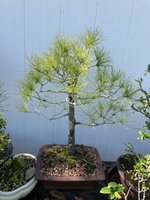Weaponman
Yamadori
New to the forum, but have been into bonsai for 6 years, especially native species and some tropicals.
I wanted to share my experiences with the sand pine, pinus clausa, which seems to have bonsai potential but given it’s limited range, it likely isolated to zones 8-10. Further complicating is lack of commercial availability, so collecting from scrub forests is the only option. In its natural environment the Sand Pine grows in a xeric habitat, It is typically the dominant canopy tree In scrub forests. They typically have a lower branch persistence better than slash Pine with sparse back budding, So you need to find thicker ones with many low branches or start with smaller ones to train early.
I have collected around a dozen or so in the last few years, late winter is best so typically January or February. I have found that after collecting and cutting tap root immediately putting into mostly inorganic bonsai soil Minimizes oversaturation in grower pots. Given the extremely fine sand that it naturally grows in, it quickly becomes too heavy dense and wet in a pot. Larger specimens may need 2 root pruning to reduce tap root and encourage shallower root systems.
i’m still learning about it through trial and error. Killed a few, but I’m Now trying to treat it like a JBP or a slash Pine. Trying to encourage smaller growth. Seems like needle length is easily reduced.
I’m also experimenting with feeding, it’s natural environment it grows in relatively in organic soil’s so I’m thinking I don’t want to overfeed.
Soil mix is approximately 50% lava, 10% pine bark, 10% sharp large sand grit, 10% turface, 10% pumice. Repot in spring, major prune and witein fall, decandle in late spring or early summer. Candles seem to come early and throughout summer. Trying to see if I can get a third flush.
Styling is typically formal upright or flat top style. You can find stunted ones in part shade in forest with twin trunks as well.
I’ve even started pre-chopping and pruning some in a forest patch and coming back the following year to collect because they are a strong grower in the ground if left alone.
Included a few photos of some of the ones I have had for a few years. Trunk thickness of 1-1/2”-2”.
Has anybody had any experience with these?
Thanks




I wanted to share my experiences with the sand pine, pinus clausa, which seems to have bonsai potential but given it’s limited range, it likely isolated to zones 8-10. Further complicating is lack of commercial availability, so collecting from scrub forests is the only option. In its natural environment the Sand Pine grows in a xeric habitat, It is typically the dominant canopy tree In scrub forests. They typically have a lower branch persistence better than slash Pine with sparse back budding, So you need to find thicker ones with many low branches or start with smaller ones to train early.
I have collected around a dozen or so in the last few years, late winter is best so typically January or February. I have found that after collecting and cutting tap root immediately putting into mostly inorganic bonsai soil Minimizes oversaturation in grower pots. Given the extremely fine sand that it naturally grows in, it quickly becomes too heavy dense and wet in a pot. Larger specimens may need 2 root pruning to reduce tap root and encourage shallower root systems.
i’m still learning about it through trial and error. Killed a few, but I’m Now trying to treat it like a JBP or a slash Pine. Trying to encourage smaller growth. Seems like needle length is easily reduced.
I’m also experimenting with feeding, it’s natural environment it grows in relatively in organic soil’s so I’m thinking I don’t want to overfeed.
Soil mix is approximately 50% lava, 10% pine bark, 10% sharp large sand grit, 10% turface, 10% pumice. Repot in spring, major prune and witein fall, decandle in late spring or early summer. Candles seem to come early and throughout summer. Trying to see if I can get a third flush.
Styling is typically formal upright or flat top style. You can find stunted ones in part shade in forest with twin trunks as well.
I’ve even started pre-chopping and pruning some in a forest patch and coming back the following year to collect because they are a strong grower in the ground if left alone.
Included a few photos of some of the ones I have had for a few years. Trunk thickness of 1-1/2”-2”.
Has anybody had any experience with these?
Thanks







